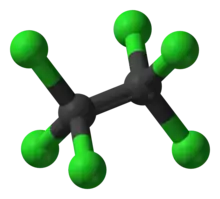Hexachloroethane
Hexachloroethane, also known as perchloroethane (PCA) is the organochlorine compound with the formula (CCl3)2. It is white solid at room temperature with a camphor-like odor.[3] It has been used by the military in smoke compositions, such as base-eject smoke munitions (smoke grenades).
 | |
 | |
| Names | |
|---|---|
| IUPAC name
Hexachloroethane | |
| Other names
Carbon hexachloride, Ethane hexachloride, Perchloroethane | |
| Identifiers | |
3D model (JSmol) |
|
| ChEBI | |
| ChEMBL | |
| ChemSpider | |
| ECHA InfoCard | 100.000.606 |
| EC Number |
|
| KEGG | |
PubChem CID |
|
| UNII | |
CompTox Dashboard (EPA) |
|
| |
| |
| Properties | |
| C2Cl6 | |
| Molar mass | 236.74 g/mol |
| Appearance | colorless crystals[1] |
| Odor | camphor-like[1] |
| Density | 2.091 g/mL at 25 °C |
| Melting point | sublimes |
| Boiling point | 183 to 185 °C (361 to 365 °F; 456 to 458 K) |
| 0.005% (22.2 °C)[1] | |
| Vapor pressure | 0.2 mmHg (20 °C)[1] |
| -112.7·10−6 cm3/mol | |
| Hazards | |
| Main hazards | Probable carcinogen, dangerous CNS depression |
| NFPA 704 (fire diamond) | |
| Flash point | noncombustible[1] |
| Lethal dose or concentration (LD, LC): | |
LD50 (median dose) |
4460 mg/kg (rat, oral) 4970 mg/kg (guinea pig, oral) |
| NIOSH (US health exposure limits): | |
PEL (Permissible) |
TWA 1 ppm (10 mg/m3) [skin][1] |
REL (Recommended) |
Ca TWA 1 ppm (10 mg/m3) [skin][1] |
IDLH (Immediate danger) |
Ca [300 ppm][1] |
Except where otherwise noted, data are given for materials in their standard state (at 25 °C [77 °F], 100 kPa). | |
| Infobox references | |
Manufacture
Chlorination of tetrachloroethylene at 100–140°C with the presence of ferric chloride is the most commonly used commercial production method, however several other methods exist. A high purity form can be produced in a small scale by reacting chlorine together with barium carbide.[4]:101 In September 1997, it was reported as no longer being produced in the United States for commercial distribution, but was produced as a by-product of industrial chlorination process.[4]:101
Applications
Hexachloroethane has been used in the formulation of extreme pressure lubricants. It has also been used as a chain transfer agent in the emulsion polymerization of propylene tetrafluoroethylene copolymer. Hexachloroethane has been used as an anthelmintic in veterinary medicine, a rubber accelerator, a component of fungicidal and insecticidal formulations as well as a moth repellant and a plasticizer for cellulose esters.[3]
Hexachloroethane has been used in the manufacture of degassing pellets to remove hydrogen gas bubbles from molten aluminum in aluminum foundries. This use, as well as similar uses in magnesium, is being phased out in the European Union.[5]
Use as smoke agent
Smoke grenades, called hexachloroethane (HCE) smoke or HC smoke, utilize a mixture containing roughly equal parts of HCE and zinc oxide and approximately 6% granular aluminium. These smokes are toxic, which is attributed to the production of zinc chloride (ZnCl2).[6][7] According to Steinritz et al., "Due to its potential pulmonary toxicity," zinc chloride producing smoke grenades "have been discharged from the armory of most western countries (...)."[8]
Toxicity
Hexachlorethane is not particularly toxic when taken orally,[9] but is considered to be quite toxic by skin adsorption. The primary effect is depression of the central nervous system.[3] The IDLH is given as 300 ppm and the OSHA PEL is 1 ppm (skin).[9] It is reasonably anticipated to be a carcinogen.[10]
References
- NIOSH Pocket Guide to Chemical Hazards. "#0316". National Institute for Occupational Safety and Health (NIOSH).
- "Hexachloroethane". Immediately Dangerous to Life and Health Concentrations (IDLH). National Institute for Occupational Safety and Health (NIOSH).
- Snedecor, Gayle (1999). "Hexachloroethane". In Kroschwitz, Jacqueline I. (ed.). Kirk-Othmer Concise Encylclopedia of Chemical Technology (4th ed.). New York: John Wiley & Sons, Inc. p. 428. ISBN 978-0471419617.
- "HEXACHLOROETHANE 101" (PDF). September 1997.
- ECHA, Annex XVII to REACH – Conditions of restriction, Restrictions on the manufacture, placing on the market and use of certain dangerous substances, mixtures and articles, entry 41: hexachloroethane
- "Appendix E: Smoke And Masking Agents" (PDF). Australian Department of Veteran Affairs. December 2003. p. E-3. Archived from the original (PDF) on 2014-02-13. Retrieved 2012-10-04.
- National Research Council (1997). Toxicity of Military Smokes and Obscurants, volume 1. Subcommittee on Military Smokes and Obscurants. Washington, DC: National Academy Press. p. 127
- Steinritz, D., Zehfuß, F., Stenger, B., Schmidt, A., Popp, T., Kehe, K., Mückter, H., Thiermann, H., Gudermann, T. (2018). Zinc chloride-induced TRPA1 activation does not contribute to toxicity in vitro. Toxicology Letters, 293, 133–139. doi:10.1016/j.toxlet.2017.09.008
- "Documentation for Immediately Dangerous To Life or Health Concentrations (IDLHs) Hexachloroethane". NIOSH. May 1994. Retrieved 2012-10-04.
- "Report on Carcinogens, Twelfth Edition, Hexachloroethane" (PDF). NIH. 2011. Retrieved 2012-10-04.

